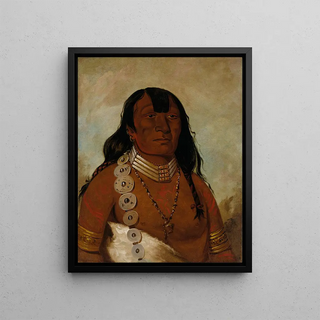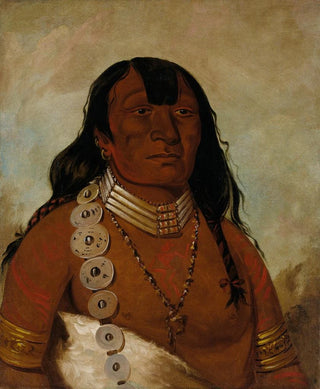Art print | Th-Tot-Sah better known as Tohausen Little Bluff First Chief - George Catlin


View from behind

Frame (optional)
Reproduction Th-Tot-Sah, better known as Tohausen Little Bluff First Chief - George Catlin – Engaging Introduction
The art print Th-Tot-Sah, better known as Tohausen Little Bluff First Chief - George Catlin, embodies a captivating encounter between art and history. This iconic piece, created by American artist George Catlin, offers a valuable glimpse into Native American culture in the 19th century. By painting this chief of the Sioux tribe, Catlin does not merely capture his subject’s physical appearance but also immortalizes the spirit and identity of a vanishing people. The canvas resonates with emotional depth, inviting viewers to immerse themselves in a world where indigenous traditions and rituals are celebrated and preserved.
Style and uniqueness of the work
Catlin’s style is distinguished by his attention to detail and his vibrant color palette. In this piece, he manages to convey the dignity and strength of Tohausen, while highlighting the cultural elements surrounding him. The traditional clothing, adorned with symbolic motifs, testifies to refined craftsmanship and a rich history. The facial features of Tohausen, both powerful and serene, are painted with such precision that they seem almost alive. This ability to capture the very essence of his models makes Catlin a pioneer in the representation of indigenous peoples. His artistic approach, blending realism and emotion, gives this art print a uniqueness that continues to inspire art lovers and historians alike.
The artist and his influence
George Catlin, often regarded as one of the first artists to document Native American life, played a crucial role in preserving their cultural heritage. Traveling across the United States, he met numerous tribes and created a series of portraits and scenes of daily life, forming a body of work that testifies to the diversity and richness of Native American cultures. His commitment to authentic representation of indigenous peoples had a lasting impact on art and anthropology. By presenting his works to the public, Catlin raised awareness of the need to preserve these cultures in the face of colonial expansion.

Matte finish

View from behind

Frame (optional)
Reproduction Th-Tot-Sah, better known as Tohausen Little Bluff First Chief - George Catlin – Engaging Introduction
The art print Th-Tot-Sah, better known as Tohausen Little Bluff First Chief - George Catlin, embodies a captivating encounter between art and history. This iconic piece, created by American artist George Catlin, offers a valuable glimpse into Native American culture in the 19th century. By painting this chief of the Sioux tribe, Catlin does not merely capture his subject’s physical appearance but also immortalizes the spirit and identity of a vanishing people. The canvas resonates with emotional depth, inviting viewers to immerse themselves in a world where indigenous traditions and rituals are celebrated and preserved.
Style and uniqueness of the work
Catlin’s style is distinguished by his attention to detail and his vibrant color palette. In this piece, he manages to convey the dignity and strength of Tohausen, while highlighting the cultural elements surrounding him. The traditional clothing, adorned with symbolic motifs, testifies to refined craftsmanship and a rich history. The facial features of Tohausen, both powerful and serene, are painted with such precision that they seem almost alive. This ability to capture the very essence of his models makes Catlin a pioneer in the representation of indigenous peoples. His artistic approach, blending realism and emotion, gives this art print a uniqueness that continues to inspire art lovers and historians alike.
The artist and his influence
George Catlin, often regarded as one of the first artists to document Native American life, played a crucial role in preserving their cultural heritage. Traveling across the United States, he met numerous tribes and created a series of portraits and scenes of daily life, forming a body of work that testifies to the diversity and richness of Native American cultures. His commitment to authentic representation of indigenous peoples had a lasting impact on art and anthropology. By presenting his works to the public, Catlin raised awareness of the need to preserve these cultures in the face of colonial expansion.






